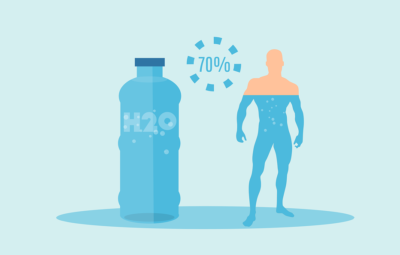What is Vitamin D3 and why do we need it?
Vitamin D is a nutrient that helps the body absorb calcium. It is important for strong bones and teeth and also helps the immune system function. A lot of people do not get enough vitamin D and this can lead to problems such as osteoporosis and Rickets.
Vitamin D can be obtained by spending time in the sun, but this might not be possible all year round. An alternative would be to consume foods that are rich in vitamin D. This would guarantee that the body gets the nutrients needed for good health.
If you don’t have enough vitamin D, it can lead to health problems like rickets, a weaker immune system, and an increased risk of cancer. You might also have problems with your hair and bones.
If you take in too much vitamin D, it can cause your body to overproduce calcium. This excess calcium can then lead to health problems such as heart disease or kidney stones.
In order to absorb Vitamin D, you must consume fat. Fish, mushrooms, and other items exposed to sunlight are high in Vitamin D. Additionally, fortified milk, milk substitutes, and tofu also contain Vitamin D. Finally, pork chops, eggs, and fortified breakfast cereals are also sources of Vitamin D.
Vitamin D is a hormone that the body produces when skin is exposed to sunshine. This accounts for almost 90% of our total vitamin D intake, with only 10% derived from food. 20 minutes of sunshine a day is enough to satisfy your vitamin D needs.
What does fat-soluble mean?
A fat-soluble vitamin is a vitamin that can be stored in the body for long periods of time. These vitamins dissolve in fats and oils and are absorbed along with these nutrients. Vitamins A, D, E, and K are examples of fat-soluble vitamins.
The body stores vitamins A, D, E, and K in the liver and fatty tissues. Because these vitamins can be stored in the body, you don’t need them every day. You only need fat-soluble vitamins when you have a deficiency of them.
What are some of the best ways to increase my vitamin D3 levels?
The most effective way to increase your vitamin D levels is by spending time in the sun regularly. You can also take vitamin D supplements or eat foods that are high in this vitamin.
The best way to increase your vitamin D3 levels is to eat foods that are rich in vitamin D. The following is a list of 13 foods that are high in vitamin D and should be a regular part of your diet:
1. Cod Liver Oil
Omega-3 fatty acids are a type of fat that is essential for human health, but the body cannot make them on its own.Fish is the best source of omega-3s, and this oil is full of them. It also contains a lot of vitamin D, which is important for bones and many other body systems. You can take it as a supplement, or add it to food.
2. Certain Mushrooms
Mushrooms are the only source of vitamin D that can be found in the produce aisle, states the Mushroom Council. However, growers have the ability to expose this low-calorie, high-fiber food to ultraviolet (UV) light in order to boost its levels of vitamin D. The mushrooms that are likely to soak up big quantities of the UV light include brown (crimini), portobello, maitake, and white. Check the food label for any mention of vitamin D or UV exposure.
3. Swordfish
If you’re looking to add more fish to your diet, swordfish is a great option. It has a mild, sweet flavor, is low in calories, and only takes a few minutes to cook. Swordfish is also versatile and can be grilled, baked, broiled, or pan-roasted. However, you should eat it sparingly as it contains high levels of mercury.
4. Yogurt
Protein-rich yogurt that is fortified with vitamin D can contain approximately 80 IU (per 6-ounce serving). However, many of the fortified versions of this breakfast and snack food are flavored, which means the sugar count can be on the high side. The healthiest option is to choose one that is unflavored.
5. Salmon
Popular cold-water fish salmon is excellent source of heart-healthy omega-3 fatty acids, as well as protein, minerals, and vitamins—one being vitamin D. One serving, which is 3 ounces, contains 447 IU. Salmon can be enjoyed pan-fried, grilled, smoked, baked, broiled, seared, or sautéed. It’s recommended to opt for fresh or frozen wild-caught salmon, if available.
6. Halibut
One of the benefits of halibut is that it is a light tasting fish. It is also a good source of essential nutrients including potassium, vitamin B-6, vitamin B-12, zinc, and magnesium. A 3-ounce serving provides about 200 IU of vitamin D. Although darker meat fishes contain more omega-3s, halibut is still a good choice for a food that is high in essential fatty acids.
7. Milk
One cup of milk can contain 115 to 124 IU of vitamin D if it is fortified. Keep in mind that milk alternatives, such as rice milk, coconut milk, and almond milk, may or may not have a substantial amount of vitamin D depending on the brand and product.
8. Tuna Fish
This inexpensive canned fish is a good source of omega-3 fatty acids, potassium, phosphorus, and vitamin A. It is also a good source of the sunshine vitamin, containing 154 IU in a 3-ounce serving.
9. Orange Juice
One cup (or 8 ounces) of orange juice can contain up to 137 IU of vitamin D.yet not all juices are created equal—read the product label to make sure your carton of orange juice is not from concentrate and is fortified with vitamin D (and most likely calcium, as well).
10. Sardines
Sardines are small, cheap fish that come in a can and have many health benefits. They contain immune-boosting vitamin B-12, anti-inflammatory selenium, bone-healthy phosphorus, and vitamin D. Just two sardines contain 46 IU of vitamin D. You can eat them in a salad or as a snack on a cracker.
11. Beef Liver
Although beef liver may not sound appealing, it is a high-quality source of protein containing 42 IU of vitamin D. This nutrient-rich meat also provides iron, zinc, vitamin A, and folate, which are essential for cellular health, immunity, vision, and DNA repair.
12. Eggs
The yolks are the most important part of the egg. The small yellow ball in the center of the egg contains 41 IU of vitamin D. Eggs have been unfairly demonized in the past, but they are actually a very nutritious food. They are high in protein and can be eaten at any time of day. However, it is important to note that eggs contain saturated fat, which can raise blood cholesterol levels. If you have high LDL cholesterol, you should talk to your doctor.
13. Breakfast Cereal
If you’re looking to get your daily dose of vitamin D, breakfast is the perfect time to do it. A cup of fortified cereal will give you around 40 IU of the vitamin, but cereals made with whole grains are even better, providing you with even more of the vitamin. Adding a glass of milk to your breakfast will give you double or even triple the amount of vitamin D.
How much vitamin D3 is found in most vitamin D rich foods?
In a study published in the Journal of Nutrition, it was found that the vitamin D3 concentrations in nineteen different foods ranged from 2.8 to 142 μg/100 g.
The concentration of the nutrient varied greatly from food to food, with an average of 31.53 μg/100 g. The study found that the top food sources of vitamin D were fish, mushrooms, and fortified foods like milk and cereals.
Who is at risk for vitamin D3 deficiency?
Many different groups of people are at risk for low vitamin D levels. Those people include:
The elderly
Vitamin D is generated in the skin from exposure to UV radiation. As people age, however, their skin becomes less efficient at producing vitamin D from the sun. As a result, they need to consume foods or supplements that contain vitamin D.
People who have problems absorbing fat
Vitamin D is a fat-soluble nutrient, which means it is found in fats and must be absorbed by the body in order to be used.
People taking certain medications
A number of factors can lead to a vitamin D deficiency, including the use of corticosteroids. These steroids reduce calcium absorption and make it harder for the body to produce vitamin D.
Weight-loss medicines that contain orlistat, as well as cholesterol-lowering treatments that use cholestyramine, can reduce the body’s ability to absorb vitamin D and other fat-soluble vitamins.
Vitamin D is necessary for calcium absorption. Anti-seizure medications that include phenobarbital and phenytoin have been linked to vitamin D deficiency and reduced calcium intake.
Are there any risks associated with consuming too much vitamin D?
Vitamin D toxicity can cause nausea, vomiting, weakness, and weight loss. It can also lead to more serious problems like kidney stones and damage to the kidneys. If you take supplements, be sure to follow the recommended dosage.
If you have any of the following symptoms, you may be taking too much vitamin D and should stop taking supplements immediately. These symptoms include: feeling nauseous, vomiting, poor appetite, constipation, feeling weak, and weight loss. If you experience any of these, please reach out to your healthcare provider.
If you experience any of the symptoms of vitamin D toxicity, stop taking supplements and contact your healthcare provider.
How can I boost my vitamin D fast?
There are several things you can do to increase your levels of vitamin D: 1. Get some sun exposure. 2. Eat foods that are high in vitamin D, such as the ones featured today. 3. Take a supplement. 4. Use a UV lamp.
If you follow these tips, you can make sure you get enough vitamin D for your health.
too much vitamin D can lead to kidney stones, the most common side effect. To avoid this, drink plenty of fluids and consult with a doctor if you feel you are taking too much.
There are a few things you can do to make sure you’re getting enough vitamin D. First, spend time outside every day. Even if it’s just a few minutes, exposing yourself to sunlight will help your body produce vitamin D. You can also eat foods that are rich in vitamin D, such as salmon, eggs, and fortified milk. Finally, take a supplement if you don’t think you’re getting enough vitamin D from your diet. By following these tips, you can make sure you’re getting enough vitamin D to maintain your health.
What happens if vitamin D3 is low?
If you are not getting enough vitamin D, you may be at risk for health problems like bone loss, muscle weakness, falls, and fractures. You may also experience mood changes like depression and anxiety.
In children, a lack of vitamin D can cause rickets, a condition that leads to the bones becoming soft and weak.
How can I check my vitamin D levels at home?
Home tests for vitamin D levels usually require taking a small blood sample by pricking and squeezing a finger. It is simpler to test for levels of 25-OH D, which stays in the body for approximately 14 days, because it is easier to spot changes in levels that are linked to vitamin D deficiency.
What is a normal D3 level?
The ideal level of vitamin D is between 20 and 50 ng/mL. Anything below 20 ng/mL is considered insufficient, and anything above 50 ng/mL is considered toxic. The best way to make sure you’re getting enough vitamin D is to eat foods that are rich in the nutrient.
What causes low vitamin D?
There are several things that can lead to low vitamin D levels including a lack of sun exposure, having dark skin, being obese, and having certain medical conditions such as Crohn’s disease.
Lack of sun exposure is the most common cause of vitamin D insufficiency. However, there are a number of other conditions that can lead to vitamin D deficiency. Sunlight is the most prevalent source of vitamin D, but other factors can contribute to the problem.
How much sun do you need for vitamin D?
To maintain adequate vitamin D levels, you need to expose yourself to the sun for around 15 minutes every day. This can differ depending on your skin tone and the season, though. For example, if you have dark skin, you might need 30 minutes of sun exposure daily.
To maintain healthy blood concentrations, spend 10-30 minutes in midday sunlight at least several times a week. Those with darker skin may need somewhat more than this. The amount of time you spend in the sun will depend on how sensitive your skin is to sunlight.







